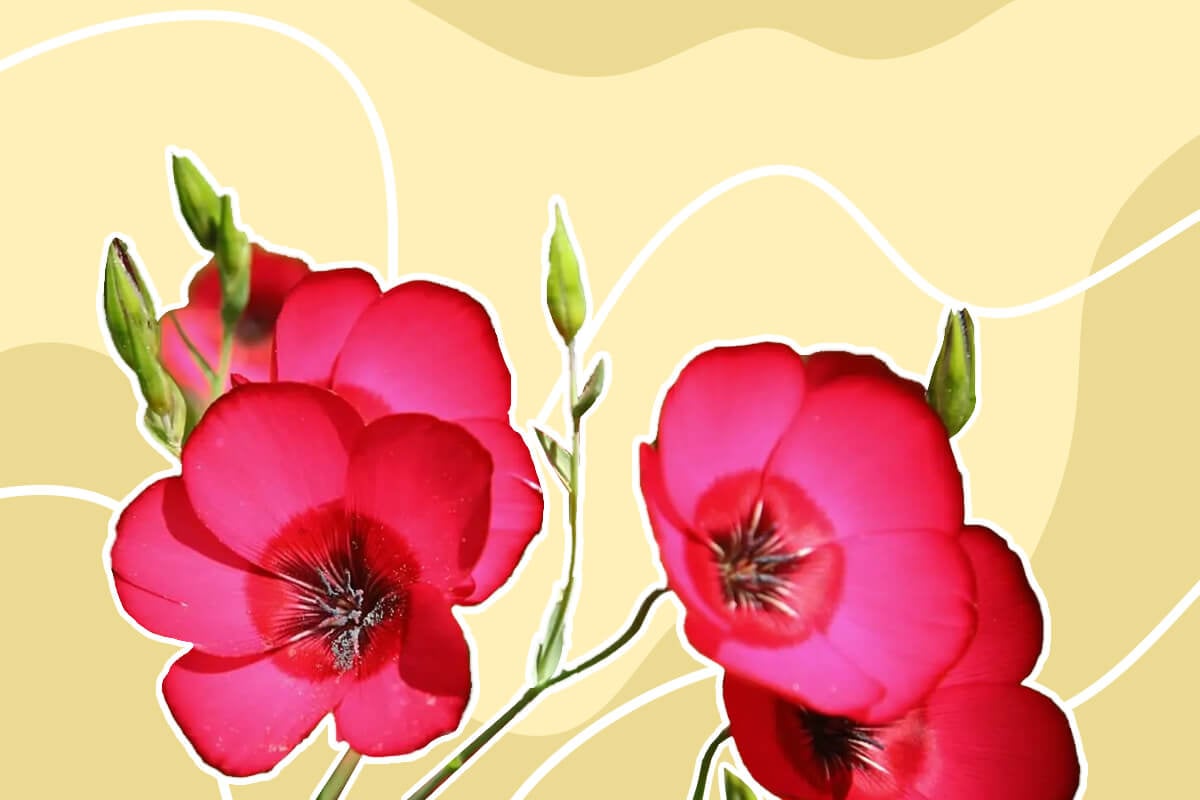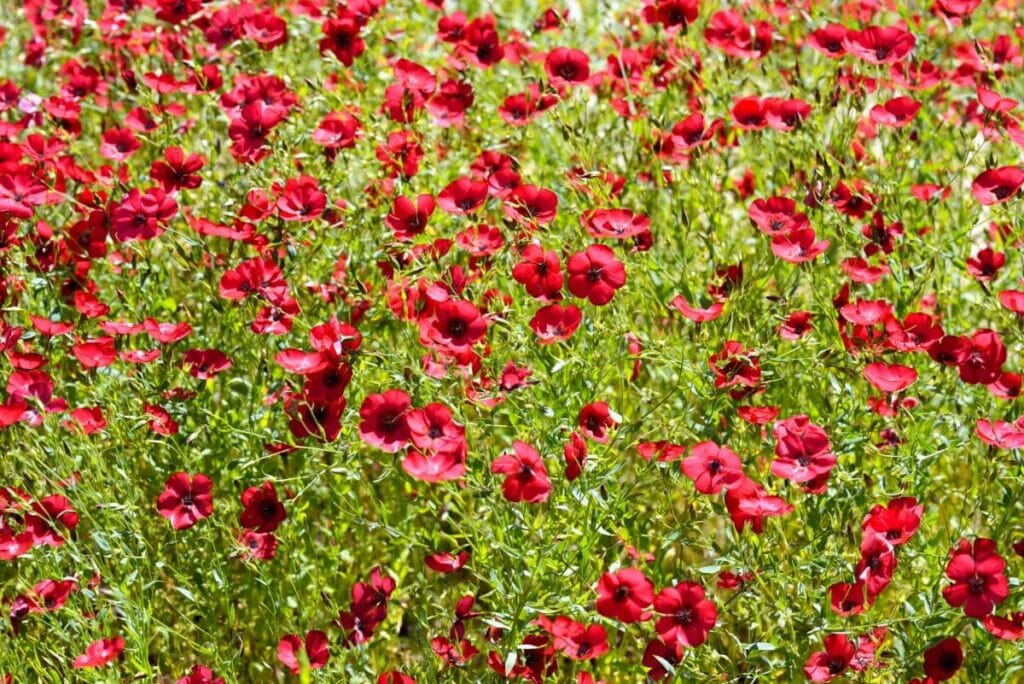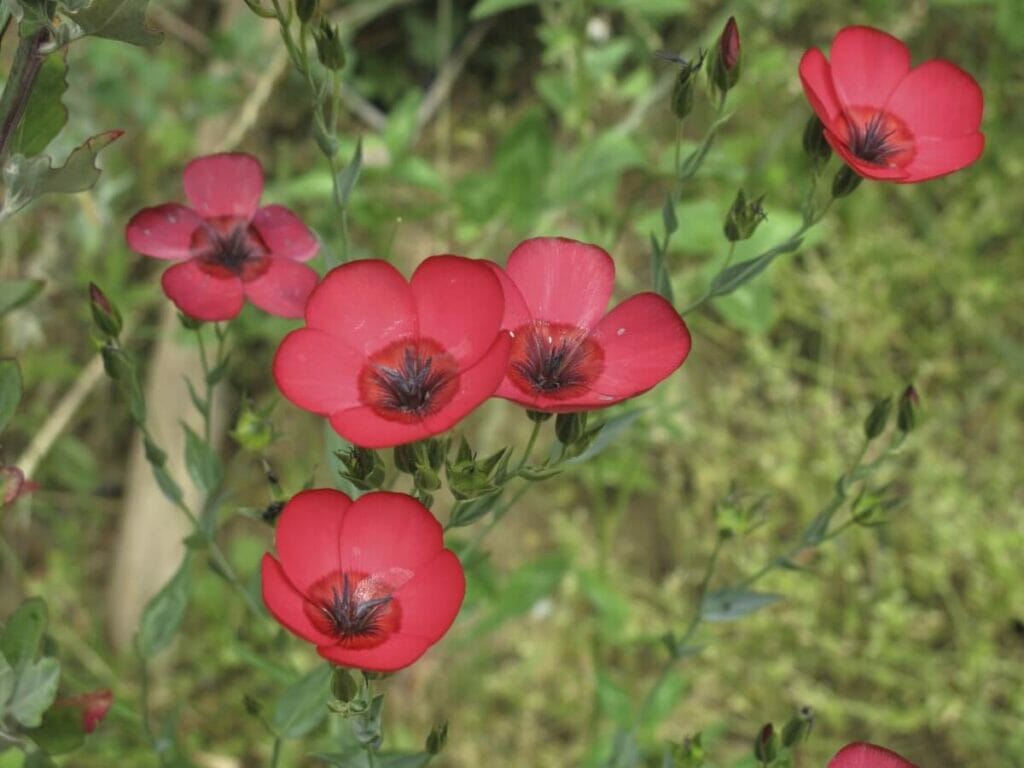Red Flax: Growing and Care Guide Essentials
Gardeners of all levels love finding beautiful and easy-to-grow species for their gardens. If you’re on the lookout for this type of plant, Linum grandiflorum, or Red Flax, is the perfect contender. This annual herb grows hardily in fields and gardens, producing beautiful, bright red flowers. Here, I’ll take you through everything you need to know about growing and caring for Red Flax, including planting, soil considerations, light preferences, feeding, pruning, and over-winter care.

Red Flax Plant Care – Key Takeaways:
| Botanical Name: | Linum grandiflorum |
| Also Known As: | Red Flax, Scarlet Flax, Crimson Flax |
| Hardiness Zones: | USDA growing zones 1 to 10 |
| Flowering Months: | From spring to autumn, depending on location. |
| Growing Difficulty: | Easy. Suitable for beginners. |
| Type of Plant: | Annual herb |
| Light Requirements: | Bright, direct sunlight. Will tolerate partial shade. |
| Temperature and Humidity: | Thrives in temperatures anywhere from 30 to 90 degrees Fahrenheit and most humidity levels. |
| Watering Needs: | If planted in your garden, Red Flax will likely receive the water it needs from precipitation. Water enough to moisten soil if rainfall is less than one inch per week in your area. |
| Soil Preferences: | Well-draining, slightly moist soil. It can be slightly acidic, neutral, or slightly alkaline. |
| Feeding: | This plant doesn’t enjoy nutrient-rich soil, so there’s no need to fertilize. |
| Growth Expectations: | Will reach one to two feet tall and six inches to one foot wide. |
| Toxicity: | Non-toxic to humans and pets. |
How to Grow Red Flax

Best Locations to Plant
The best locations to grow Red Flax is in garden beds or open fields and meadows. Make sure to plant it in a spot that gets plenty of full sun throughout the day.
Best Times of Year to Plant
The best time of year to plant will depend on when you want its flowers to bloom. For earlier blooms, you can sow seeds during the fall. Plant seeds in early spring for blooms in the summer months.
Growing from Seed vs. Planting Young Nursery Plants
It’s best to grow from seed, as they can be tricky to transplant. This is because the plant has delicate roots that are easily damaged during the transplanting process.
Starting Red Flax in your garden is easy, but it’s possible to relocate seedlings if needed. Some gardeners start this species in peat pots indoors. This can facilitate an easy transfer and secure earlier blooms.
What to Do Before Planting
Before you plant, find a spot in your garden with plenty of direct sunlight. Make sure you have enough space to plant the seeds around six inches apart.
Now, grab the tools you need to plant this species, such as a garden spade or hoe, scissors, or insecticide. The Essential Tools section below lists everything you need to plant seeds.
Best Soil Types
Your Red Flax plant will love a well-draining, slightly moist soil. The plant doesn’t require a specific pH level. It can handle environments that range from slightly alkaline to slightly acidic.
However, one thing Flax plants are particular about is soil fertility. Interestingly, they will bloom best in soil with a low fertility level.
How to Plant
It’s finally time to plant your Red Flax. Here are a few steps to follow when sowing the seeds in your garden: 1.
- Get soil ready by removing any weeds and raking the top layer of soil. You can use a gardening hoe or spade to loosen up the top six inches.
- Scatter seeds on the soil’s surface around six inches from one another. Press them gently into the soil without covering completely.
- Water the area and keep it moist for a few weeks until seeds begin to germinate.
- If transplanting, do so before these new plants fully develop root systems.
Light Preferences
Red Flax thrives in bright, direct sunlight. However, the species will also tolerate partial shade if necessary.
Temperature and Humidity Preferences
Fortunately, Red Flax’s hardy nature means it can endure temperatures from 30 to 90 degrees Fahrenheit. It is not particular about humidity levels and is tolerant of drought conditions.
Plant Care Essentials

Watering
Red Flax is an easy plant to care for in every sense, and its watering schedule is no exception. Typically, the species receives all of the hydration it needs from precipitation.
You’ll only want to consider occasional watering if rainfall is below an average of one inch per week in this plant’s environment.
Fertilizing
Remember, Flax plants grow best in low-fertility soil. This means fertilization is usually unnecessary for this plant. If you think your Red Flax is suffering from poor soil quality, you can apply a low dose of diluted fertilizer.
Pruning and Cutting Back
You may prune withered foliage and flowers any time throughout the year. Use clippers to cut back these areas and create a tidier appearance. Just be sure not to cut areas where any new growth is forming.
Propagation
The best way to propagate red flax is by seed. After the seeds dry on the plant, collect them to create new Linum grandiflorum plants.
Another great thing about this plant is that it will self-sow its seeds. This means that if you’re looking to produce more Red Flax, the plant will naturally reproduce itself without any work on your part.
Overwintering
Like other Linum varieties, Crimson Flax is tolerant of cold conditions. So, this plant won’t typically need special care for overwintering.
Transplanting
It is usually easier to plant seeds directly in the ground. Still, many gardeners choose to start them in containers and transplant them later. Consider the plant’s root system if you take this approach, as it won’t handle damage well.
You can also start this plant in small peat pots to make the transplanting process easier. Follow the steps in the How to Plant section when transplanting your seedlings.
Deadheading
It is not necessary to deadhead your plant. However, if you prefer a tidier look, you can trim away any old and withered foliage after the plant’s growing season has ended.
Common Problems and How to Treat Them

Signs of Watering Issues
Drought-hardy Red Flax likely receives plenty of hydration from precipitation. However, sitting in a soggy environment may cause this plant to develop fungal root rot.
If you notice signs of root rot, remove the affected area with care. Replace any infected areas with a fresh, clean soil mix.
Signs Red Flax is Getting Too Little Light
If your plant receives too little light, it may not produce its best blooms. The best way to prevent this is by making sure you plant seeds in a location that receives plenty of bright, direct sunlight.
Common Pests and Diseases
Now, you will need to watch for a few garden diseases and pests to keep your Linum grandiflorum growing happily. Here are a few of the common issues that may come up with this species.
- Aphids
- Flax bollworm
- Cutworms
- Rust
- Rhizoctonia
- Fusarium wilt
If you notice pests infesting your plant, remove visible insects manually. Treat the plant with an insecticide until the issue subsides. Applying diatomaceous earth will help with cutworm issues.
Fungal issues like rust, fusarium wilt, and Rhizoctonia need to be addressed immediately. Remove any affected soil and plants, and avoid planting new plants in the infected soil.
Essential Tools to Have Around

Here is the full list of tools and materials that you will need to grow and care for your plants.
- Scissors
- Well-draining soil
- A gardening spade or hoe
- Diluted fertilizer, only if the soil is particularly poor
- Insecticide
- Diatomaceous earth
- Container for storing harvested seeds
Wrapping Up
With showy blooms and minimal care needs, Scarlet Flax is sure to make gardening a joy.
Keep its care requirements in mind, and this plant will reward you with plenty of growth and color. Now that you’re ready to grow Linum grandiflorum, it’s time to head out and get digging!
Brandy Wells is an American copywriter and content writer living in Spain. From hiking in her hometown near the Smoky Mountains to digging in the dirt in rural Oregon, she has always put a love of nature at the heart of her endeavors. These days, you’ll catch her writing content, and of course, taking breaks to tend to her growing houseplant collection.

